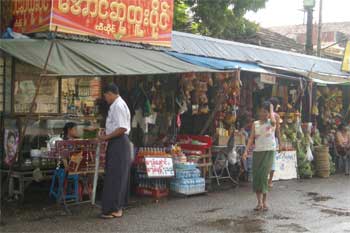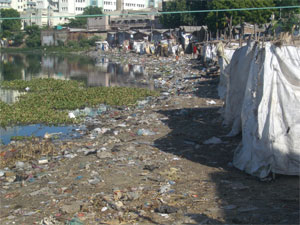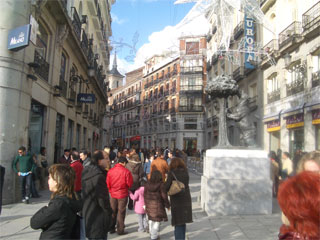Semester at
Sea Fall
2006 Voyage 
- Home Page
- My Bio
- Comparative
Global
Cities Project: From Slums to Starbucks
- The Japanese City: Modern and
Traditional
- Vietnam: Vernacular at Heart
- Myanmar: Poor in Wealth; Rich in Culture
- India: A World of Contradictions
- Egypt: Cairo: A Globalizing City
- Spain: Madrid: Old Beauty Mixed
with Modernity
- Open Letter
Crossing the Globe: From Slums to
Starbucks
On August 28, 2006 I had the pleasure of
boarding the MV
Explorer, and setting sail for the world. I
knew that spending three months away from my home
University in
Pittsburgh to explore nine countries I had never been to before, was
going to
lead me into some pretty interesting places and positions.
Each country brought new experiences and new
sights, but there was one thing that was apparent in every country I
visited:
the growing urbanization of the world.
 In each
country Semester at Sea ported in, I was exposed to extremely large
cities. Some of the large cities I
visited were very westernized, global cities that listened to western
music,
and wore western styled clothes. However,
most of the cities I visited were not typically
thought of as
true global cities even though they had very large population densities. Instead, most of the cities I visited
including, Ho Chi Minh City, Yangon, Chennai, and Cairo were all cities
that
are composed of both vernacular urban spaces and transnational urban
spaces.
In each
country Semester at Sea ported in, I was exposed to extremely large
cities. Some of the large cities I
visited were very westernized, global cities that listened to western
music,
and wore western styled clothes. However,
most of the cities I visited were not typically
thought of as
true global cities even though they had very large population densities. Instead, most of the cities I visited
including, Ho Chi Minh City, Yangon, Chennai, and Cairo were all cities
that
are composed of both vernacular urban spaces and transnational urban
spaces.
In most of
the developing world cities that I visited, I was exposed to two
completely
different types of life that coexisted in the same city.
Since the entire world is facing a growing
trend of urbanization, and many of the new people coming into the city
are very
poor, I saw and visited a large amount of people living in urban slum
housing. Many times people living in
slums, live without access to basic necessities of life, leaving them
to create
vernacular and local urban spaces.
 However, though there are many
people living in slums in
these new mega
cities, there are also people are making money and succeeding in world
business. As a result, many developing
world cities, are building world trade centers, wearing western style
fashion,
and enjoying western delicacies.
However, though there are many
people living in slums in
these new mega
cities, there are also people are making money and succeeding in world
business. As a result, many developing
world cities, are building world trade centers, wearing western style
fashion,
and enjoying western delicacies.
India: A World of Contradictions
Urban scholars have known for a long time that urbanization was going to take place around the world. However, what they did not anticipate was how incredibly fast urbanization was going to move throughout the entire world. Mike Davis writes in his book, Plant of the Slums, that in 1950 there were only about eighty-six cities that had populations that exceeded one million people. In today’s world there are approximately four hundred cities that have populations of over one million people. Davis also emphasizes, that well cities all over the world are growing in population, it is mostly the developing world that is experiencing enormous population growth.
As a result
of the population boom in many developing world cities, a housing
crisis has
been created. There is simply not
enough housing for all of the new urban dwellers, most of who are
coming in
from the rural, countryside hoping to escape poverty.
Since there is not enough efficient housing in many of
today’s
developing world cities, slums have become the place for most of the
city’s
poor to live. Often times slums have no
electricity, running water, or basic public health facilities such as
the slum
I visited in India.
 Unfortunately, because the people
of slums are poor and inconsequential to country politics, they are
often moved
against their will whenever the government feels it necessary. Donald Seekins writes in his article, The
State and the City: 1988 and the transformation of Rangoon, that
more then
450,00 people of Yangon, Myanmar have been uprooted from their urban
homes and
moved out to the outskirts of town where new slums can form. This is not an unusual case because most
people seem to forget or don’t care that slum-dwellers also have lives
that
revolve around living in one area of town.
Unfortunately, because the people
of slums are poor and inconsequential to country politics, they are
often moved
against their will whenever the government feels it necessary. Donald Seekins writes in his article, The
State and the City: 1988 and the transformation of Rangoon, that
more then
450,00 people of Yangon, Myanmar have been uprooted from their urban
homes and
moved out to the outskirts of town where new slums can form. This is not an unusual case because most
people seem to forget or don’t care that slum-dwellers also have lives
that
revolve around living in one area of town.
Even though slums often do not provide even the most basic living necessities and the dwellers are often given fewer rights, they are frequently the leading vernacular spaces in an urban area. Interestingly, slums are usually found in global cities, and are usually a world away from western global culture. From my experience in the Indian slum, the people from the area, who I met, seemed to retain much more of the Indian culture then the wealthy Indian family that I stayed with in the second part of my India visit. Part of this may because these people have very few resources and little access to modern day technology.
While slums
in the developing world are usually large vernacular spaces, they are
not the
only place where the vernacular exists. In
fact vernacular spaces can be found in any city around
the world,
even in Madrid, Spain. Simply looking
at the architecture of Spanish buildings a person can see vernacular
spaces. However, there does seem to be
a shift to a more transnational culture in many western cities. For example, there were dozens of to-go
Starbucks Coffee shops lining the Madrid streets.

Another example of the shift in culture is that vernacular culture is increasingly being transformed into transnational entertainment. For example, Mary Crain writes in her article, The Pilgrimage to the Shrine of El Rocio, about a sacred religious pilgrimage and celebration that takes place every year in southern Spain. However, in recent years tourists from all over Europe have been coming to Spain to watch and take part in the celebration. One tourist company even used the slogan, “Return to Tradition,” to get people to come to the religious ceremony. It seems to me, that the vernacular tradition in Spain could be destroyed if the pilgrimage becomes more of a family vacation then a religious ceremony.
In today’s world, it is becoming increasingly harder to tell the difference between where the vernacular ends and the transnational begins. Slums are often thought of as vernacular spaces yet they have come to be a symbol of the transnational city, and in many places, local traditions are now becoming transnational entertainment.
As my
Semester at Sea voyage came to an end, I found myself trying to grasp
everything that I had learned about the global city, both in class and
from the
different countries that I visited. I
came to realize that while every city I visited was filled with
different
people, different traditions, even different religions, each city was
struggling with the same problems. Many
of the challenges that cities are facing today are a result of a rapid
urbanization and rapid globalization.

With high
numbers of rural dwellers moving into the city, a housing crisis has
erupted in
many developing world cities. In
response to this population increase, mega-slums have become common in
many
cities around the world. Unfortunately,
slums are run down housing, with little or no running water and
electricity. Basic life necessities are
often missing from slum dwellings, leaving their inhabitants to often
live in
filth and unhealthy living conditions.
Though
slums in developing world cities are becoming a huge problem, they are
not the
only problem that world cities are currently facing.
All large cities of the world are currently going through
a
process of globalization. As a result,
it is becoming increasingly difficult to tell where the transnational
begins
and the vernacular ends. Because of the
globalization phenomenon many world cities, such as Madrid, are losing
parts of
their old culture to the transnational movement. I
find this very troubling because I must wonder if there will
ever come a time when almost all world cities embrace the same type of
culture.